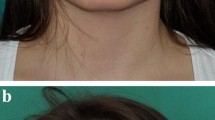Abstract
White North American men (n = 75) and women (n = 75) were surveyed to investigate gender specific preferences of nasion position, which may aid plastic surgeons in nasal shaping during rhinoplasty. The subjects were asked to rank preferences of various nasion positions from life-size, scaled, sketched male and female profiles. Nasion positions with regard to height (anterior projection) and level (vertical position) were altered, whereas all other facial and nasal anthropometric measurements were held constant. The nasion heights were drawn at 7, 10, and 13 mm anteriorly to the corneal plane, and the nasion levels were drawn at the supratarsal fold (ST), upper lid ciliary margin (CM), midpupil (MP), and lower limbus (LL). The rank selections made by the female and male subjects of both gender profiles demonstrated statistical significance, as demonstrated by one-way analysis of variance (ANOVA) of ranks (p < 0.001). Further analysis using a post-Dunn test was completed to delineate significant gender specific preferences for the aesthetic nasion level and height. Female nasion levels were preferred at CM or MP over LL or ST on the basis of female ranks, and at ST, CM, or MP over LL on the basis of male ranks (p < 0.05 for all comparisons). Additionally, female nasion heights were preferred at 10 mm > 13 mm > 7 mm anterior to the corneal plane on the basis of both female and male ranks (p < 0.05 for all comparisons). Male nasion levels were preferred at ST, CM, or MP over LL on the basis of both male and female ranks (p < 0.05 for all comparisons). Male nasion heights were preferred at 10 mm > 13 mm > 7 mm anterior to the corneal plane by both male and female ranks (p < 0.05 for all comparisons). In summary, both the male and female subjects strongly disliked a low nasion height of 7 mm and a low nasion level placed at LL for both gender profiles. Both the male and female subjects were most particular concerning nasion height, preferring a 10-mm projection and strongly disliking a deeper 7-mm height for both male and female profiles. Both the male and female subjects were more tolerant of nasion level alterations. Whereas the male subjects tolerated nasion levels at ST, CM, or MP for either gender profile, the female subjects preferred only nasion levels at CM and MP for the female gender. Overall, these findings may lend support to recent trends in radix augmentation during rhinoplasty, especially among male patients.




Similar content being viewed by others
References
DG Becker NJ Pastorek (2001) ArticleTitleThe radix graft in cometic surgery. Arch Facial Plast Surg 3 115–119 Occurrence Handle10.1001/archfaci.3.2.115 Occurrence Handle1:STN:280:DC%2BD3M3nsFKiuw%3D%3D Occurrence Handle11368664
H Borman F Ozgur G Gursu (1999) ArticleTitleEvaluation of soft tissue morphology of the face in 1,050 young adults. Ann Plast Surg 42 280–288 Occurrence Handle1:STN:280:DyaK1M7psVarsQ%3D%3D Occurrence Handle10096619
S Byrd PC Hobar (1993) ArticleTitleRhinoplasty: a practical guide for surgical planning. Plast Reconstr Surg 91 642–654 Occurrence Handle1:STN:280:ByyC1cbns1U%3D Occurrence Handle8446718
MB Constantian (1989) ArticleTitleAn alternative strategy for reducing the large nasal base. Plast Reconstr Surg 83 41–52 Occurrence Handle1:STN:280:BiaD2s3gtVI%3D Occurrence Handle2909077
MB Constantian (2000) ArticleTitleFour common anatomic variants that predispose to unfavorable rhinoplasty results: a study based on 150 consecutive secondary rhinoplasties. Plast Reconstr Surg 105 316–333 Occurrence Handle1:STN:280:DC%2BD3c%2FptVChug%3D%3D Occurrence Handle10627002
RK Daniel (1996) The radix. . . (Eds) Aesthetic plastic surgery rhinoplasty. Little, Brown, and Company Boston 151–168
Daniel RK: The radix and the nasofrontal angle. In: Dallas Rhinoplasty Symposium. pp 331–340, 1996
RK Daniel LG Farkas (1988) ArticleTitleRhinoplasty: image and reality. Clinc Plast Surg 15 1–10 Occurrence Handle1:STN:280:BieC2M7jsFM%3D
LG Farkas (1981) Results. . . (Eds) Anthropometry of the head and face in medicine. Elsevier North Holland, New York 28–30
LG Farkas TA Hreckzko JC Kolar IR Munro B Chir (1984) ArticleTitleVertical and horizontal proportions of the face in young adult North american Caucasians: revision of neoclassical canons. . 75 328–336
LG Farkas JC Kolar IR Munro (1986) ArticleTitleGeography of the nose: a morphometric study. Aesthetic Plast Surg 10 191–223 Occurrence Handle1:STN:280:BiiC38vhs1c%3D Occurrence Handle3812136
LG Farkas IR Munro (1987) Anthropometric facial proportions in medicine. Thuomas Springfield, IL l67–169
LG Farkas P Shom MJ Katic RI Munro B Chir (1985) ArticleTitleInclinations of the facial profile: art versus reality. Plast Reconstr Surg 75 509–519 Occurrence Handle1:STN:280:BiqC28nnvVI%3D Occurrence Handle3983251
IB Goldman (1961) ArticleTitleRemoval of the nasal hump. Arch Otolaryngol 74 51–55
Gunter JP: Facial analysis for the rhinoplasty patient. In: Dallas Rhinoplasty Symposium. 1996: 23-24.
B Guryon (1988) ArticleTitlePrecision rhinoplasty: Part I. The role of life-size photographs and soft tissue cephalometric analysis. Plast Reocnstr Surg 81 489–499
B Guryon (1988) ArticleTitlePrecision rhinoplasty: Part II. Prediction. Plast. Reconstr Surg 81 500–550 Occurrence Handle3347658
M-L Lessard RK Daniel (1985) ArticleTitleSurgical anatomy of septorhinoplasty. Arch Otolaryngol 111 25–29 Occurrence Handle1:STN:280:BiqD1MnktFw%3D Occurrence Handle3966894
N Powell B Humphreys (1984) Proportions of the aesthetic face. Thieme-Stratton New York 64–67
JH Sheen (1984) Radix. . . (Eds) Aesthetic rhinoplasty. Quality Medical Publishing St. Louis 70–74
JH Sheen (1987) ArticleTitleTh radix as a reference in rhinoplasty. Perspect Plast Surg 1 33–35
JH Sheen AP Sheen (1987) Aesthetic rhinoplasty. St. Louis Mosby 1322–1327
ME Tardy R Brown (1997) Rhinoplasty: the Art and the science. WB Saunders Philadelphia, PA 453–459
RC Webster TM Davidson RC Smith (1979) ArticleTitleNasofrontal angle changes in rhinoplasty. Otolaryngol Head Neck Surg 87 95–108 Occurrence Handle1:STN:280:Bi%2BD2MrktVQ%3D Occurrence Handle503481
SA Yellin (1997) ArticleTitleAesthetics for the next millennium. Facial Plast Surg 13 231–239 Occurrence Handle1:STN:280:DyaK1czitFSgtg%3D%3D Occurrence Handle9656878
Author information
Authors and Affiliations
Corresponding author
Additional information
Accepted to the ASPS-PSEF-ASMS 2002 Annual Meeting
Rights and permissions
About this article
Cite this article
Mowlavi, A., Meldrum, D.G. & Wilhelmi, B.J. Implications for Nasal Recontouring: Nasion Position Preferences as Determined by a Survey of White North Americans. Aesth. Plast. Surg. 27, 438–445 (2003). https://doi.org/10.1007/s00266-004-3083-9
Published:
Issue Date:
DOI: https://doi.org/10.1007/s00266-004-3083-9




